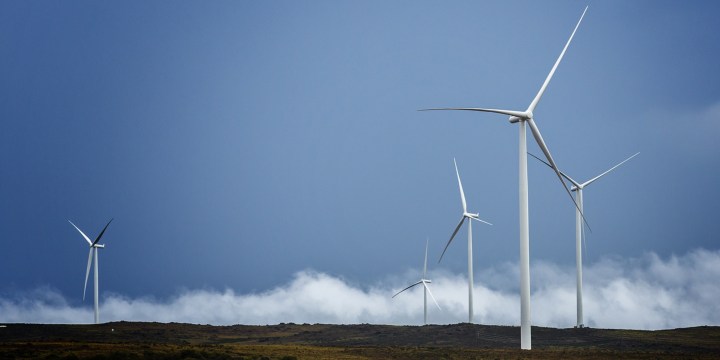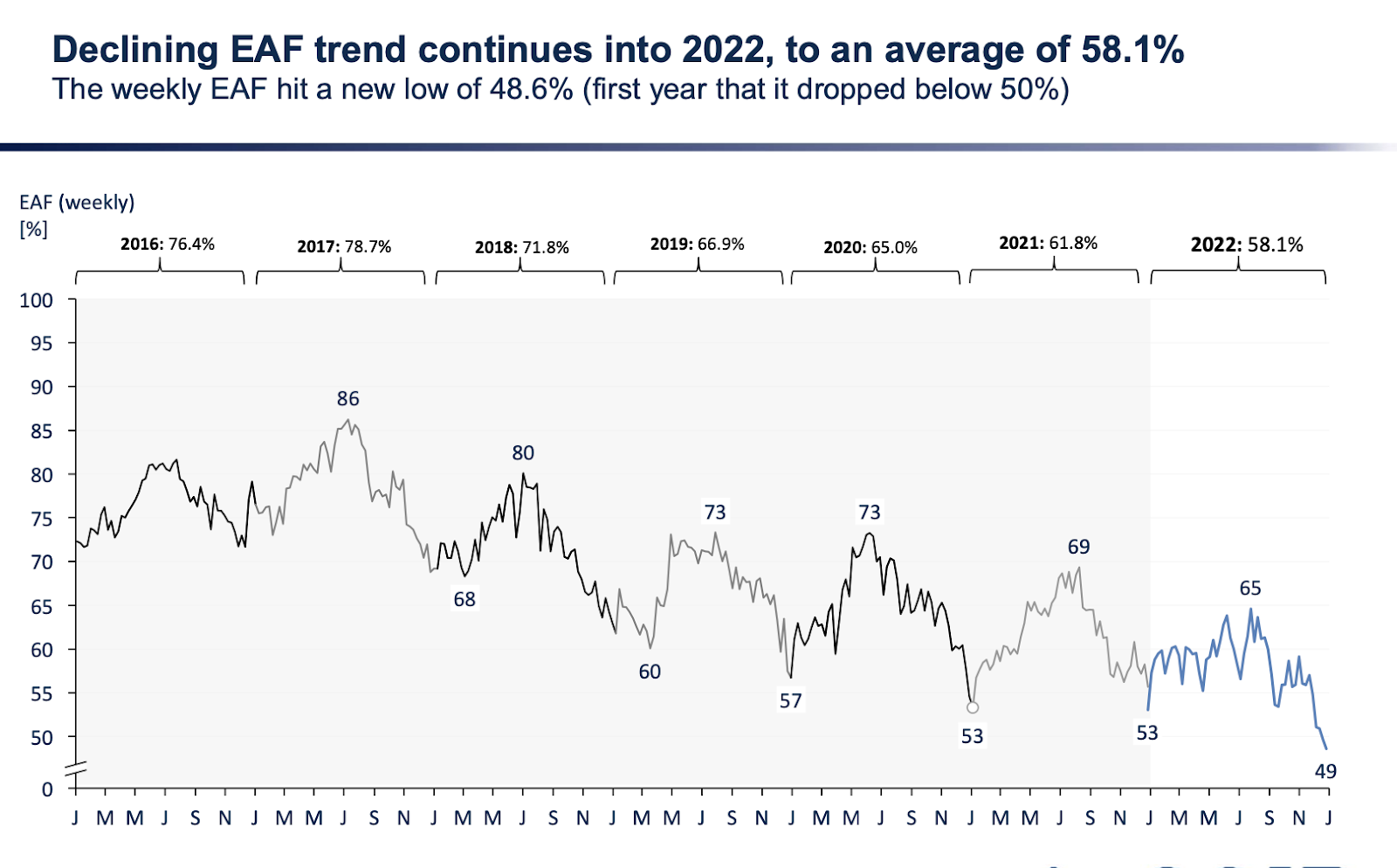POWER CRISIS
Renewables help generate rare good news on Eskom’s winter blackouts

The less intense blackouts boil down to five factors. Cooler winter months bode well for the performance of Eskom’s coal-fired power plants. Renewable energy (mainly wind) has generated a lot of electricity. The maintenance of Eskom’s power stations has been reduced. Eskom is burning diesel. Also, intensive energy users, like mining companies, usually shut down their operations for maintenance.
How has Eskom managed to drastically reduce the intensity of blackouts from crippling Stage 6 to Stage 3 over the past two weeks?
Before the improvement in the electricity situation, South Africa was anticipating unprecedented Stage 8 blackouts — or worse — during this winter.
But households and industries have gone from not having electricity for 10 hours on average (depending on which parts of the country you are based in) to two hours.
It was predictable and expected that this would happen because Eskom’s fleet of coal-fired power stations in Mpumalanga always performs better during colder winter months than in hot summer conditions. This has been the case going back seven years when looking at Eskom’s energy availability factor (EAF), the main metric for assessing the performance of the power utility’s 14 power stations.
An EAF refers to the average percentage of power stations available to dispatch energy at any one time. A higher EAF indicates that Eskom’s power stations are performing well and also lowers the probability of higher blackout stages.
Data from the Council for Scientific and Industrial Research (CSIR) show that over the past seven years, between 2016 and 2022, Eskom’s power stations have produced a high EAF during winter, especially during the June months. In the graph below, the EAF peaks during June, labelled “J”.

(Source: Council for Scientific and Industrial Research)
The same trend has been observed in June this year, with Eskom’s EAF, which has been languishing below 53% for most of 2023, increasing by seven percentage points to 60% — a level last seen in September 2022.
From a physics and engineering perspective: Colder weather allows a coal-fired power plant to operate more efficiently and at higher output. This is because there is no need to regularly cool down power stations when they run during winter. Eskom’s better-performing power stations include Tutuka, Duvha, Kendall and Majuba — all coal-fired power plants based in Mpumalanga.
Kgosientsho Ramokgopa, the new electricity minister, told Daily Maverick in a recent interview: “Even if the cooling towers fail, they can still run and cool down the power stations. When it is cooler, the machines are more efficient.”
Whereas during summer or hot temperatures, components at power stations are sensitive, and more susceptible to breakdowns, which necessitates higher stages of blackouts.
The cooler temperatures are resulting in fewer unplanned breakdowns at Eskom, which have averaged around 15,000 megawatts (MW) in recent days, requiring less intense stages of blackouts. In May 2023, Eskom breakdowns were anything between 18,000MW and 19,000MW, which necessitated the implementation of Stage 6 or higher blackouts, according to Eskom’s generation executive, Eric Shunmagum.
So, cooler days during the official start of winter in June have led to 3,000MW fewer breakdowns at Eskom power stations.
Renewables save the day
But cooler temperatures during winter are not the only reason the electricity situation has improved. Eskom’s electricity generation profile has also been boosted by renewable energy sources, mainly wind energy.
The cooler and windy weather conditions during winter are prime conditions for wind energy projects to generate more electricity. Wind energy in the Western and Eastern Cape has consistently produced between 1,000MW and 2,000MW of electricity over the past two weeks, an analysis by Daily Maverick of data from Eskom has shown. Wind energy, at its generation peak (2,000MW), relieved South Africa from two stages of blackouts.
The generation profile of wind energy is not to be underestimated, considering that a unit at Eskom’s Koeberg nuclear power station in Cape Town and three units at Kusile power station in Mpumalanga are all not generating electricity as they are out for maintenance. Together, the units can generate about 2,100MW of electricity, which is not available. But wind energy stepped in to fill the lost capacity.
Also helping to improve the electricity situation is that the planned maintenance of power stations has been cut, allowing the power stations to run. This might come to haunt Eskom at a later stage. According to Eskom, planned maintenance has been reduced in line with the power utility’s winter plan to about 3,000MW (less than half of what is normally done in summer). These megawatts are what is offline due to maintenance, whereas, during summer or hotter months, at least 6,000MW is offline due to maintenance.
Another boost to Eskom is that intensive electricity users, such as mining companies, have shut down their large operations for maintenance. The maintenance programmes of mining companies require them to shut down their operations, resulting in lower demand for electricity and placing less pressure on Eskom. The shutdown of mines usually coincides with the increase in Eskom’s electricity tariffs (approved by the energy regulator, Nersa), the season of which occurs between 1 April and 1 July.
And last, if Eskom faces higher electricity demand, mostly during the evenings, it burns diesel to run its open-cycle gas turbines (OCGTs). Diesel is used for powering the OCGTs at Ankerlig and Gourikwa, which have a combined energy generation capacity of 2,000MW, which is equivalent to two stages of rolling blackouts. Eskom’s current spending on diesel is about R3-billion a month.
An analysis by Daily Maverick has shown that Eskom has been relying less on OCGTs. The number of OCGTs it uses has been between five to 18 (as of 25 June). Eskom usually uses more than 18 OCGTs during emergency periods. In other words, Eskom is currently quite prudent in burning diesel. DM



















R3-billion on diesel a month for OCGT’s equates to over 150million Litres of diesel at retail price… (Eskom surely doesn’t pay retail price, which means a much larger volume of diesel)
How does this diesel get to the turbines and who is supplying at what price?
R3-billion bucks a month = R36-billion bucks a year… This better be money well spent!!
Unfortunately, if you read the other articles about Diesel, I believe Eskom pays at or above Retail, due to BEE-Requirements and intermediaries, and they also pay as if they are driving a car, thus they also pay RAF and other road-use taxes. So probably only 2/3rds the volume of what you calculated?
Without ESKOM there would no PetroSA which is why they turned down ESKOM’s application to procure diesel directly. Goes to show how much PetroSA and their boss the DMRE are interested in the country’s problems
“Also helping to improve the electricity situation is that the planned maintenance of power stations has been cut, allowing the power stations to run.” Koko philosophy. Short term gain can be long term pain.
Stick to coal, at least until we can build more nuclear stations or something else comes along
It must really hurt that renewables are doing so well!
What Ray did not comment on is politics. Eskom (or rather load shedding) has become so politicised that it’s hard to believe that politics aren’t playing some role. Perhaps I am wrong, which would be great. This article does present facts which dispel the politics theory. I would also be interested in knowing more about diesel procurement. De Ruyter’s book does talk about some dodgy deals there.
While not disagreeing with the above one must also consider the mindset of the workers at the ‘coalface’. Firstly, after the departure of De Ruyter, they no longer have a ‘white’ boss and secondly the recent 7% increase eases the economic pain slightly. I think I read somewhere that the average Eskom salary was about 700k. 7% on that is 4k per month! Another increase would permanently end load shedding until the entire coal ‘fleet’ explodes.
“It was predictable and expected that” [ loadshedding would be reduced to two hours per day in winter].
Please provide just one reference to experts predicting that. All we heard about was Stage 8.
Yes, please do.
And just like that, with the departure of De Ruyter and Oberholzer, the Minister of Electricity has miraculously brought us back from the brink! Now for Transnet, SAA et al to fall under his spell as well. Hmmm….
The ANC converted Eskom into a grand wealth redistribution scheme whereby paying customers get milked to pay for electricity of Soweto and other ANC supporters.
Nothing to do with rich or poor!
In this elaborate scheme of the ANC, skin colour and political affiliation determine whether you are the ‘eater’ or the ‘eaten’.
But the scheme is failing because of two lethal flaws.
1. Greed … of the cadres! They stole Eskom broke!
2. The paying customers have left Eskom AND the country.
The ‘scheme’ has run out of money … in true communist tradition.
Eskom can never recover because the paying customers have left.
Same with the ANC!